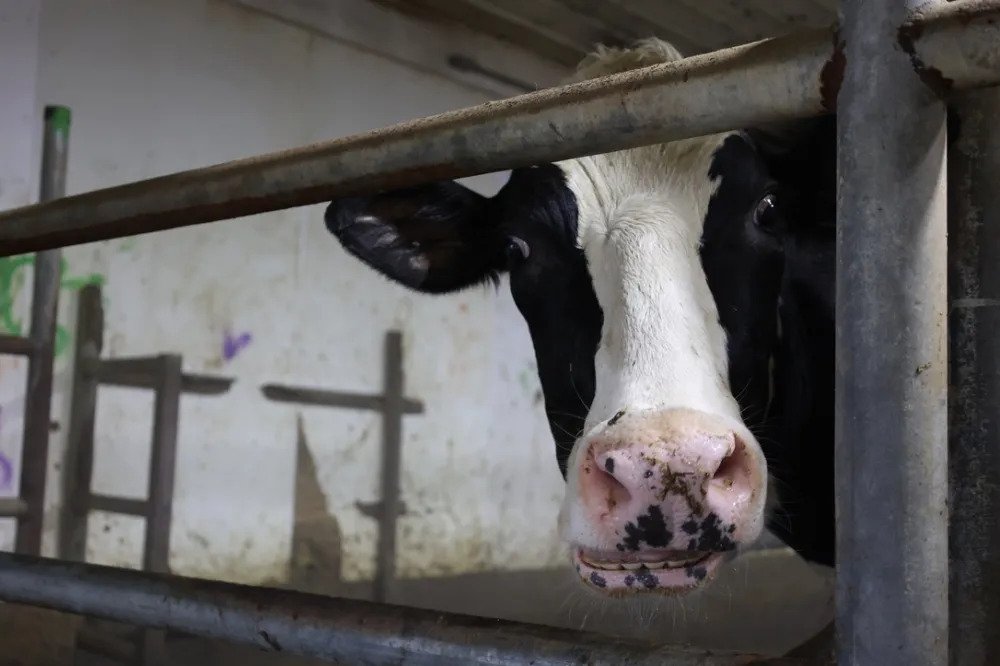Proposed cut to universal free school meals prompts pushback from local food advocates
March 26, 2025 | Noah Diedrich | Community News ServiceA cow at Kane’s Scenic River Farm in St. Albans. File photo by Catherine Morrissey
In the face of skyrocketing property taxes across the state, Gov. Phil Scott is looking for new ways to economize Vermont’s education spending.
The statewide average property tax bill increased nearly 14% last year, triggering calls for cost control and an uncharacteristic red wave in November’s election that saw the Vermont GOP pick up enough seats to undo the Democratic supermajority.
Now Scott is setting his sights on programs where he believes the state can afford to cut costs.
His latest target is the $18 million universal school meal program, a measure he allowed to become law in 2022 that provides free school meals for kids regardless of income.
However, some school nutrition professionals and supporters of Vermont agriculture are pushing back.
Kayla Strom, program manager for Northeast Organic Farming Association of Vermont, said that not only would ending free school meals for all eliminate an important resource for students, but it could damage another program that stimulates Vermont’s agricultural economy and adds nutritional value to the meals themselves.
“If universal school meals were to go away, all the systems that have been put in place — with distributors, with food service directors, with local farms — are at risk because food service directors will need to totally redo how they’re operating their meal programs,” she said.
The local foods incentive program reimburses schools for the slice of local food they serve to kids. In the first year of membership, schools receive a 15 cents per plate reimbursement. After the base year, the grant requires that they reach local purchasing requirements of 15%, 20% or 25%.
If they hit those targets, schools receive a corresponding cent reimbursement. If a lunchroom were to source 25% of its food purchases locally, then the state reimburses them 25 cents for each lunch they served.
The program has doubled in participation among schools in the last year with 12 districts reaching local purchasing targets, Strom said.
“Schools are buying more Vermont products than ever,” Strom said.
Amanda Wheeler, the governor’s press secretary, said in an email that the current financial landscape in Vermont is not sustainable for taxpayers, and that Scott’s plans to revamp the education system aim to improve student outcomes under a system Vermont residents can afford.
She did not answer questions regarding the effect cutting universal school meals would have on local food partnerships.
“The governor is proposing to roll back universal school meals because the program is regressive — we should not be asking lower income families to pay for meals for more affluent families,” Wheeler said.
Scott’s proposal to axe the free meals program wouldn’t affect all students — children from low-income families would still receive free meals subsidized by the federal government.
Families who need financial assistance will still receive it, Wheeler emphasized.
It would be a mistake to cut universal meals, Strom countered. The program brings increased revenue to Vermont farmers and reduces paperwork at schools so food service directors have more time to focus on procuring local foods and cultivating relationships with local farms and suppliers, Strom said.
The universal meals program also helps create a steady market for farmers. School nutrition programs plan their meals months, if not a year, in advance, and some serve year-round, Strom said. This is great for producers, who can depend on their steady patronage.
“Schools are a really stable market,” Strom said. “A lot of school nutrition professionals joke that a school cafeteria is the biggest restaurant in town.”
Buying more food locally means that more meals can be made from scratch, which in turn means an increase in nutritional value, Strom said. A burger made from local ground beef is preferable to a hot dog, which is highly processed.
“When you’re working with local products, you’re working with a lot less ingredients,” Strom said. “You’re also able to control a lot more of all those smaller ingredients that are showing up on a kid’s plate.”
Karyl Kent, treasurer of the School Nutrition Association of Vermont, said universal school meals have another benefit, too. Funding through the program reduces the need for schools to try and find revenue by offering processed foods sold in vending machines and a la carte sales.
The revenue from the program also supports the labor needed to prepare nutritious meals.
“If that revenue decreases, the more you’re likely to see shortcuts in kitchens again and more packaged foods, processed foods,” Kent said.
No matter what happens with free school meals, scratch meals aren’t going anywhere in Harwood Unified School District, said Erika Dolan, the district’s school food and nutrition co-director.
The central Vermont district was already purchasing 14% of its food locally before the program was put into place, Dolan said. Under universal school meals, Harwood Unified was able to raise that portion to 22% thanks to the increased revenue.
If the program were to be cut, the district’s local purchases would be stymied but not terminated altogether.
“We’re going to lose money, so we’re definitely going to do less, but we’re not necessarily going to switch to all pre-made foods,” she said. “Maybe we will not be able to offer as many options, like, you know, a salad bar.”
However, some argue that the need for education reform is too dire to pick and choose which programs to keep. Rep. Jim Harrison, R-Rutland, said he wants to bring down the state’s overhead — and it’s all on the table.
“The reality is, if we’re going to tackle school reform, we can’t let perfect be the enemy of the good,” he said. “We desperately need to reduce the costs of education, and I’m open to any and all suggestions to improve education quality (and) at the same time reduce education costs.”
On Feb. 12, John Buck, proprietor of Buck Family Maple Syrup, testified in front of the House Committee on Agriculture, Food Resiliency and Forestry in favor of the local incentive program.
Buck’s maple syrup is sold to local schools like Washington Village School, or to larger local food suppliers like the Abbey Group.
“This program has a huge cultural benefit to Vermont and Vermonters,” he said in his testimony. “It helps to keep the rural culture of Vermont alive.”
This story was originally published by Community News Service, University of Vermont’s journalism internship program.

